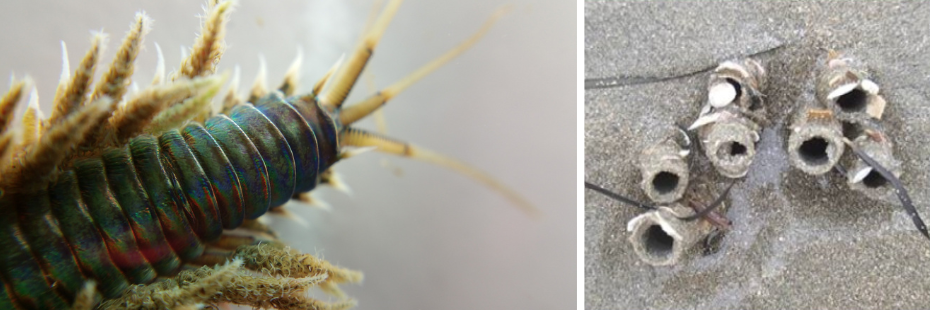PhD Students Recognized with Top Awards for Research on Estuarine Moonshine Worms
PhD students in marine biology from Stellenbosch University were awarded first and third prizes for their oral presentations on the estuarine moonshine worm, a popular bait species in the Western Cape during the recent International Polychaete Conference.
Stephanie Schoeman was awarded the first prize for her presentation titled “The reproductive strategies of Diopatra aciculata (Annelida) in the Knysna Estuary”, while Hendré van Rensburg was awarded third prize for his oral presentation titled “Expanding our understanding of the diet and trophic role of the cryptogenic estuarine moonshine worm (Diopatra aciculata) in warm temperature estuaries of South Africa”. They are both supervised by Prof. Carol Simon, a polychaete specialist in SU’s Department of Botany and Zoology.
Marine worms (with the scientific name Polychaetes) perform much the same ecological tasks as earth worms on land, that is, providing food for birds or fish, recycling marine compost and keeping the sand oxygenated by their burrowing. The more than 11 500 species display tremendous diversity, enabling them to inhabit every imaginable marine habitat.

Van Rensburg first reported on this large, tube-dwelling worm from the Knysna Estuary during his MSc studies. Previously this specific worm was confused with another species from the Mediterranean. Before that confusion was sorted out, they thought the worm to be an undescribed species endemic to South Africa. However, after DNA analysis they found that this species has also been reported from Australia: “Until further work is done, we still don’t know if it is a native species or an alien,” he explains.
The challenge, though, is that over the past 25 years this species’ population numbers have exploded: “Given its size and the fact that it changes its immediate environment, we expect it to have a significant impact on the benthic community and ecosystem,” he adds.
For his PhD research, Van Rensburg is investigating the role of this species as a consumer in the Knysna and Keurbooms estuaries. Through the combined use of physics, chemistry, biology and mathematics, he tracks special carbon and nitrogen atoms, called isotopes, through the benthic food web. This analysis will tell him what the animals are consuming and how the estuarine moonshine worm fits into the benthic food web.
“I am also extracting DNA from the guts of these worms to be able to tell more precisely which species they consume,” he adds.
Schoeman’s research investigates the origin of the worms and their dispersal patterns in South Africa: “We want to understand why the estuarine moonshine worm occurs in such high densities, despite being extensively used as bait by fishermen. In this regard I focus on the regeneration and reproduction strategies of these worms in order to shed light on how they are able to survive,” she explains.
Thus far her research has included eighteen months of fieldwork. She hopes that her research will aid in conservation efforts to preserve this diverse ecosystem and protect it as an important socio-economic resource.
Van Rensburg emphasises how important it is for biologists and ecologists to understand the interactions and connections between organisms in the benthic communities of South Africa’s estuaries, especially how major ecosystem-wide changes can be affected when there is the slightest change in a parameter.
Ultimately, it is about the protection of these ecosystems and their communities, he concludes.
The 14th International Polychaete Conference was hosted by Stellenbosch University and Iziko Museums South Africa from 3 to 7 July 2023 – the first time for the conference to be held in Africa. Prof. Simon is the immediate past president of the International Polychaete Association and also chaired the organising committee. The 119 participants from 25 countries gave 70 oral and 70 poster presentations. More than 20% of the delegates were from five African countries (South Africa, Kenya, Ghana, Tunisia, Namibia and Ethiopia) and delivered eight oral and 13 poster presentations.
“The conference was successful in fostering collaborations between African and international researchers, and we are confident that this will inspire much more polychaete research on the continent,” Prof Simon said.
The conference was preceded by an identification workshop (29 June to 1 July) which was facilitated by international experts from Spain, Russia, Brazil, France, Australia, Wales, Norway and South Africa. The 25 participants were mainly from South Africa, but also from Namibia, Ghana, Japan, and Iceland. Most local participants were professional environmental consultants or officials from the Department of Forestry, Fisheries and Environment. The workshop focussed on the identifications of polychaetes belonging to seven families that are encountered most frequently in benthic samples.

